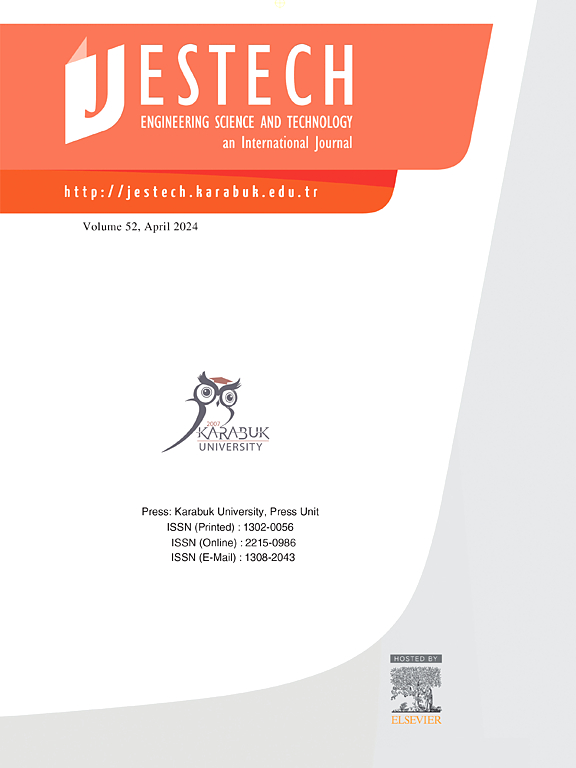Big data analysis on flow characteristics according to welded penetration locations for fire sprinkler piping system design
IF 5.4
2区 工程技术
Q1 ENGINEERING, MULTIDISCIPLINARY
Engineering Science and Technology-An International Journal-Jestech
Pub Date : 2025-07-02
DOI:10.1016/j.jestch.2025.102134
引用次数: 0
Abstract
This study presents a big data-driven computational fluid dynamics (CFD) analysis of Tee‐type fire sprinkler pipelines, focusing on how different weld penetration depths affect flow behavior and overall system performance. Over 2000 simulation cases were generated by varying key parameters, including inlet velocity, base and branch diameters, and penetration depths. The results show that deeper penetration can create pronounced recirculation zones and significant local pressure drops, especially in smaller‐diameter main pipes. These undesirable flow disturbances may undermine sprinkler efficiency by causing uneven velocity distribution or increasing cavitation risks. A regression model based on both a power‐law empirical approach and a Deep Neural Network was developed to predict average velocities at multiple monitoring points. The DNN model, supplemented by reinforcement learning, achieved a high accuracy within ±10% error, surpassing simpler regression techniques. This integrated approach highlights how big data simulations and machine learning can guide penetration depth selection, thus improving fire suppression reliability and reducing long‐term corrosion risks in sprinkler systems.
基于焊透位置的流量特性大数据分析用于消防喷淋系统设计
本研究采用大数据驱动的计算流体动力学(CFD)分析了三通型消防喷淋管道,重点研究了不同焊深对流动行为和整体系统性能的影响。通过不同的关键参数,包括入口速度、基座直径和分支直径以及穿透深度,生成了2000多个模拟案例。结果表明,较深的侵彻可以产生明显的再循环区和明显的局部压降,特别是在较小直径的主管道中。这些不受欢迎的流动干扰可能会导致速度分布不均匀或增加空化风险,从而破坏喷头的效率。建立了基于幂律经验方法和深度神经网络的回归模型来预测多个监测点的平均速度。在强化学习的辅助下,DNN模型在±10%的误差范围内实现了高精度,超过了更简单的回归技术。这种综合方法强调了大数据模拟和机器学习如何指导渗透深度选择,从而提高灭火可靠性,降低洒水系统的长期腐蚀风险。
本文章由计算机程序翻译,如有差异,请以英文原文为准。
求助全文
约1分钟内获得全文
求助全文
来源期刊

Engineering Science and Technology-An International Journal-Jestech
Materials Science-Electronic, Optical and Magnetic Materials
CiteScore
11.20
自引率
3.50%
发文量
153
审稿时长
22 days
期刊介绍:
Engineering Science and Technology, an International Journal (JESTECH) (formerly Technology), a peer-reviewed quarterly engineering journal, publishes both theoretical and experimental high quality papers of permanent interest, not previously published in journals, in the field of engineering and applied science which aims to promote the theory and practice of technology and engineering. In addition to peer-reviewed original research papers, the Editorial Board welcomes original research reports, state-of-the-art reviews and communications in the broadly defined field of engineering science and technology.
The scope of JESTECH includes a wide spectrum of subjects including:
-Electrical/Electronics and Computer Engineering (Biomedical Engineering and Instrumentation; Coding, Cryptography, and Information Protection; Communications, Networks, Mobile Computing and Distributed Systems; Compilers and Operating Systems; Computer Architecture, Parallel Processing, and Dependability; Computer Vision and Robotics; Control Theory; Electromagnetic Waves, Microwave Techniques and Antennas; Embedded Systems; Integrated Circuits, VLSI Design, Testing, and CAD; Microelectromechanical Systems; Microelectronics, and Electronic Devices and Circuits; Power, Energy and Energy Conversion Systems; Signal, Image, and Speech Processing)
-Mechanical and Civil Engineering (Automotive Technologies; Biomechanics; Construction Materials; Design and Manufacturing; Dynamics and Control; Energy Generation, Utilization, Conversion, and Storage; Fluid Mechanics and Hydraulics; Heat and Mass Transfer; Micro-Nano Sciences; Renewable and Sustainable Energy Technologies; Robotics and Mechatronics; Solid Mechanics and Structure; Thermal Sciences)
-Metallurgical and Materials Engineering (Advanced Materials Science; Biomaterials; Ceramic and Inorgnanic Materials; Electronic-Magnetic Materials; Energy and Environment; Materials Characterizastion; Metallurgy; Polymers and Nanocomposites)
 求助内容:
求助内容: 应助结果提醒方式:
应助结果提醒方式:


